
A game controller, gaming controller, or simply controller, is an input device or input/output device used with video games or entertainment systems to provide input to a video game. Input devices that have been classified as game controllers include keyboards, mice, gamepads, and joysticks, as well as special purpose devices, such as steering wheels for driving games and light guns for shooting games. Controllers designs have evolved to include directional pads, multiple buttons, analog sticks, joysticks, motion detection, touch screens and a plethora of other features.
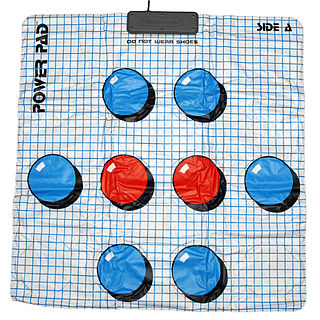
The Power Pad is a floor mat game controller for the Nintendo Entertainment System. It is a gray mat with twelve pressure-sensors embedded between two layers of flexible plastic. It was originally developed by Bandai.

The Zapper is an electronic light gun accessory launched within the Nintendo Entertainment System (NES) in North America on October 18, 1985. It is a cosmetic redesign by Nintendo of America's head designer Lance Barr, based on Gunpei Yokoi's Video Shooting Series light gun (光線銃シリーズガン), which had been released in Japan for the Famicom on February 18, 1984. The Zapper requires compatible NES games, such as Duck Hunt, Wild Gunman, and Hogan's Alley. Its internal optical sensor allows the player to aim at a television set and accurately shoot at in-game targets.

The Wii is a home video game console developed and marketed by Nintendo. It was released on November 19, 2006, in North America, and in December 2006 for most other regions of the world. It is Nintendo's fifth major home game console, following the GameCube, and is a seventh-generation console alongside Microsoft's Xbox 360 and Sony's PlayStation 3.
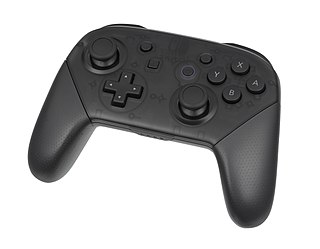
A gamepad is a type of video game controller held in two hands, where the fingers are used to provide input. They are typically the main input device for video game consoles.
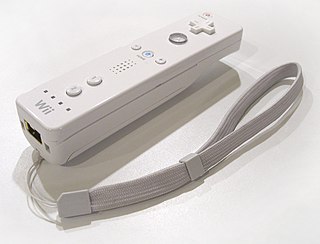
The Wii Remote, informally referred to with the portmanteau Wiimote, is the primary game controller for Nintendo's Wii home video game console. An essential capability of the Wii Remote is its motion sensing capability, which allows the user to interact with and manipulate items on screen via motion sensing, gesture recognition, and pointing using an accelerometer and optical sensor technology. It is expandable by adding attachments. The attachment bundled with the Wii console is the Nunchuk, which complements the Wii Remote by providing functions similar to those in gamepad controllers. Some other attachments include the Classic Controller, Wii Zapper, and the Wii Wheel, which was originally released with the racing game, Mario Kart Wii.

The Wii Zapper is a gun shell peripheral for the Wii Remote. The name is a reference to and successor of the NES Zapper light gun for the Nintendo Entertainment System. It is mainly used to enhance controls for shooter games, including light gun shooters, first-person shooters, and third-person shooters.

The Classic Controller is a game controller produced by Nintendo for the Wii home video game console. While it later featured some compatibility with the Wii U console, the controller was ultimately succeeded by the Wii U Pro Controller. In April 2014, Nintendo discontinued production of both the Classic Controller and Classic Controller Pro.
Nyko is an American manufacturer of third-party accessories for various gaming consoles.

Active Life: Outdoor Challenge is a 2008 video game for the Wii produced by Namco Bandai Games. Players use a mat similar to the Power Pad in conjunction with the Wii Remote in order to complete a variety of mini-games. The game is comparable to Wii Fit. As of January 30, 2009, the game has sold one million copies worldwide. A sequel, titled Active Life: Extreme Challenge, was released on August 11, 2009.
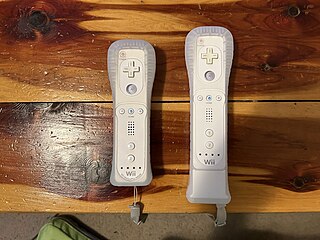
In computing, a motion controller is a type of input device that uses accelerometers, gyroscopes, cameras, or other sensors to track motion.

The GameCube controller is the standard game controller for the GameCube home video game console, manufactured by Nintendo and launched in 2001. As the successor to the Nintendo 64 controller, it is the progression of Nintendo's controller design in numerous ways. The contentious M-shaped design of its predecessor was replaced with a more conventional handlebar style controller shape; a second analog stick was added, replacing the C buttons with a C stick and the X and Y face buttons, last seen on the Super Nintendo controller, were reintroduced; the shoulder buttons were changed to hybrid analog triggers. A wireless variant of the GameCube controller known as the WaveBird was released in 2002.
Nintendo 64 accessories are first-party Nintendo hardware—and third-party hardware, licensed and unlicensed. Nintendo's first-party accessories are mainly transformative system expansions: the 64DD Internet multimedia platform, with a floppy drive, video capture and editor, game building setup, web browser, and online service; the controller plus its own expansions for storage and rumble feedback; and the RAM-boosting Expansion Pak for big improvements in graphics and gameplay. Third-party accessories include the essential game developer tools built by SGI and SN Systems on Nintendo's behalf, an unlicensed SharkWire online service, and unlicensed cheaper counterparts to first-party items. In the fifth generation of video game consoles, the Nintendo 64 had a market lifespan from 1996 to 2002.

The Wii MotionPlus (Wiiモーションプラス) is an expansion device for the Wii Remote, the primary game controller for the Wii. The device allows more complex motion to be interpreted than the Wii Remote can do alone. Both the Wii and its successor, the Wii U, support the Wii MotionPlus accessory in games.

The Nyko Kama is a third-party Nunchuk accessory created for the Wii video game console by Nyko, available in wireless or wired versions. In contrast to Nintendo's device, the controller takes its name from the traditional Japanese kama; a stealthy, curved weapon. Like the original Nunchuk, the Kama features an analog control stick, and "Z" and "C" buttons. With the use of 2 AAA batteries and an adapter dongle that plugs into the Wii Remote's expansion port, the wireless Kama is able to connect wirelessly. The wired version instead features a rumble motor, which allows it to offer force feedback when used with Nyko's Wand Wii Remote alternative.

PlayStation Move is a motion game controller developed by Sony Interactive Entertainment. Initially released in 2010 for use with the PlayStation 3 home video game console, its compatibility was later expanded to its successor, the PlayStation 4 in 2013, its PlayStation VR platform in 2016 and the PlayStation 5 in 2020. Conceptually similar to Nintendo's Wii Remote and Microsoft's Kinect, its function is based around controller input in games stemming from the actual physical movement of the player. The Move uses inertial sensors in the wand to detect motion while the wand's position is tracked using a PlayStation Eye or PlayStation Camera. The device was generally well received by critics, but has not quite met Sony's goals for integration into the market.
Since the release of the Nintendo Wii, many aesthetic, ergonomic and functional accessories have been developed by third parties for the console’s controller, the Wii Remote.
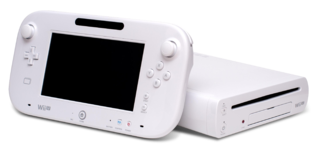
The Wii U is a home video game console developed by Nintendo as the successor to the Wii. Released in late 2012, it is the first eighth-generation video game console and competed with Microsoft's Xbox One and Sony's PlayStation 4.
















